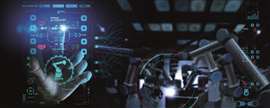Read this article in French German Italian Portuguese Spanish
Why AI isn’t the threat we imagine
25 April 2024
A persistent concern in the trades over the years has evolved around a central question: will technology take jobs?

It’s a logical concern. Especially in the age of artificial intelligence (AI), the rapid advancement and adoption of technology in the skilled trades has people around the world wondering if automation and AI will end up replacing roles once held by humans, limiting the number of opportunities available and putting current employees at risk.
From a workforce perspective, industry leaders might be faced with probing questions on this topic. But according to industry experts and insiders, as the new workforce comes of age, those working in the skilled trades shouldn’t worry too much. In fact, exploring the interaction between humans and technology is key to understanding the future of skilled trades.
For starters, fearing the arrival of automation in the skilled trades is futile – it’s already here. And to that end, there are plenty of ways automation makes it easier for skilled tradespeople in all sectors to get their work done more efficiently, accurately and cost-effectively.
For example, task-management software was designed to automate recurring responsibilities such as responding to repeated customer concerns, answering emails and scheduling appointments. Virtual reality training advances the way skilled-trades workers develop and understand specialized skills and knowledge. On the inventory management front, trade professionals who work for service-orientated businesses have found their day-to-day duties becoming more streamlined and efficient due to beneficial advancements in automated inventory-management software.
Changing landscape
The skilled trades also enjoy some additional insulation from the rapid development of technology. Automation requires stable conditions to work optimally. In other words, the more variables involved in a particular task, the harder it is for automated technology to handle. And since most skilled trades involve significant dexterity, advanced mobility and unstable environments, robots aren’t anywhere close to replacing talented tradespeople.
While there may be an increase in the use of automation and AI, this technology will likely only increase the number of jobs needed, not eliminate them. In the long run, using more technology will require actual humans to help interpret data and create automation tasks.
Ultimately, technology in the skilled trades can help improve communication, increase organisation and create flexible work schedules. Automation can help tradespeople communicate with their managers and customers quickly and more efficiently. Tech can also send reminders to ensure that jobs are completed thoroughly. This all has the potential to lead to both increased margins and growth.
And while automation isn’t the monster it’s often made out to be, it does and will continue to change the landscape of the trade industries. As leaders, what we can convey to potential workers is that the key to preserving one’s hire-ability is ensuring that one’s skills and knowledge remain up to date with the latest technology and industry demands. The marriage of skilled trade jobs and automation is not one to fear. Rather, tradespeople should embrace technology as a way to improve their attractiveness to potential employers and confirm their commitment to career longevity.
At the end of the day, skilled tradespeople who don’t know how to operate modern machinery or software will inevitably get replaced, not by the technology itself, but by the professionals who have adapted to modern times and learned the skills required to work within them.
STAY CONNECTED


Receive the information you need when you need it through our world-leading magazines, newsletters and daily briefings.
CONNECT WITH THE TEAM








